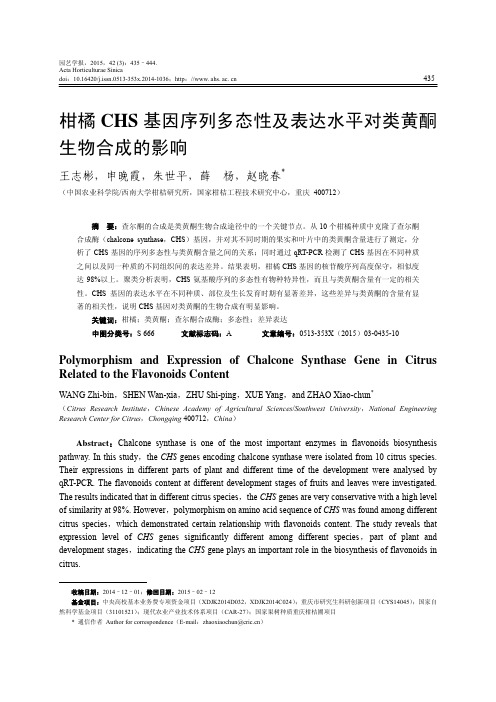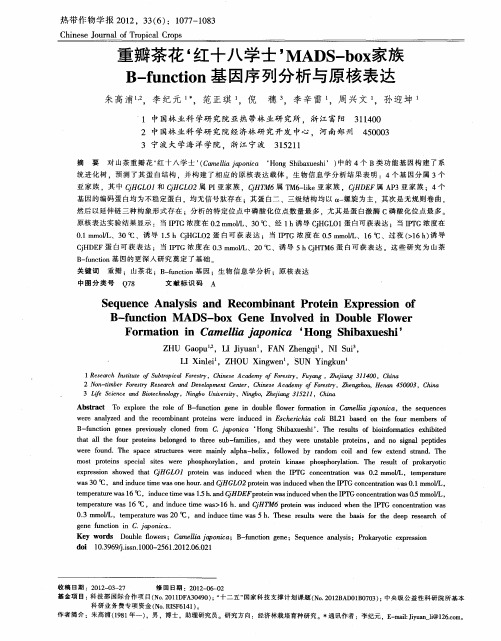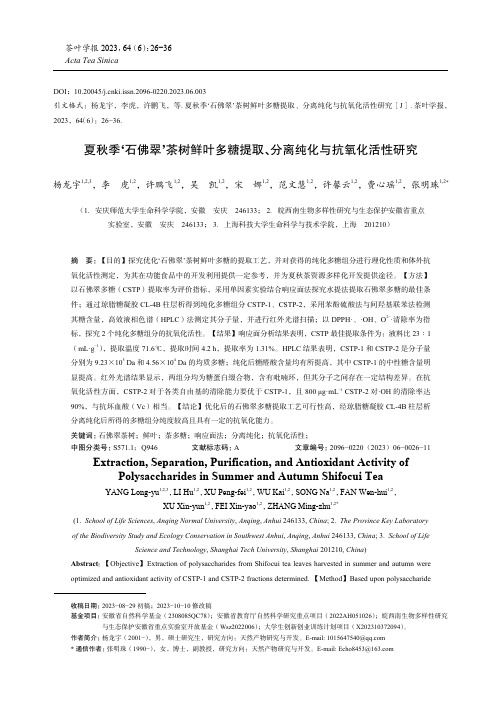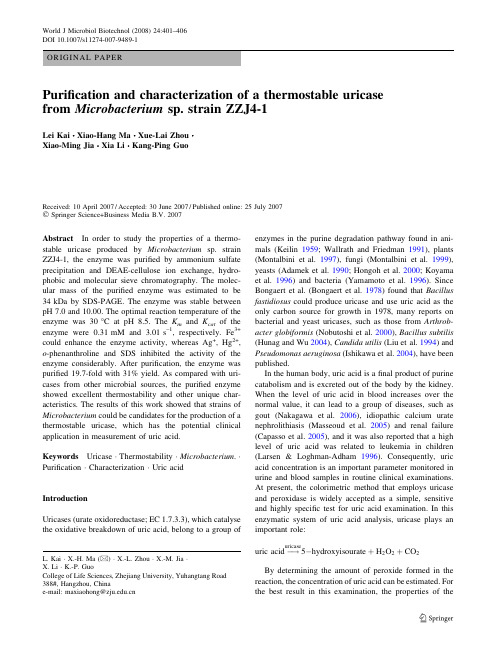Characterization of dihydroflavonol 4-reductase cDNA in tea [Camellia sinensis (.
- 格式:pdf
- 大小:3.31 MB
- 文档页数:7

园艺学报,2015,42 (3):435–444.Acta Horticulturae Sinicadoi:10.16420/j.issn.0513-353x.2014-1036;http://www. ahs. ac. cn 435柑橘CHS基因序列多态性及表达水平对类黄酮生物合成的影响王志彬,申晚霞,朱世平,薛杨,赵晓春*(中国农业科学院/西南大学柑桔研究所,国家柑桔工程技术研究中心,重庆 400712)摘 要:查尔酮的合成是类黄酮生物合成途径中的一个关键节点。
从10个柑橘种质中克隆了查尔酮合成酶(chalcone synthase,CHS)基因,并对其不同时期的果实和叶片中的类黄酮含量进行了测定,分析了CHS基因的序列多态性与类黄酮含量之间的关系;同时通过qRT-PCR检测了CHS基因在不同种质之间以及同一种质的不同组织间的表达差异。
结果表明,柑橘CHS基因的核苷酸序列高度保守,相似度达98%以上。
聚类分析表明,CHS氨基酸序列的多态性有物种特异性,而且与类黄酮含量有一定的相关性。
CHS基因的表达水平在不同种质、部位及生长发育时期有显著差异,这些差异与类黄酮的含量有显著的相关性,说明CHS基因对类黄酮的生物合成有明显影响。
关键词:柑橘;类黄酮;查尔酮合成酶;多态性;差异表达中图分类号:S 666 文献标志码:A 文章编号:0513-353X(2015)03-0435-10Polymorphism and Expression of Chalcone Synthase Gene in Citrus Related to the Flavonoids ContentWANG Zhi-bin,SHEN Wan-xia,ZHU Shi-ping,XUE Yang,and ZHAO Xiao-chun*(Citrus Research Institute,Chinese Academy of Agricultural Sciences/Southwest University,National Engineering Research Center for Citrus,Chongqing 400712,China)Abstract:Chalcone synthase is one of the most important enzymes in flavonoids biosynthesis pathway. In this study,the CHS genes encoding chalcone synthase were isolated from 10 citrus species. Their expressions in different parts of plant and different time of the development were analysed by qRT-PCR. The flavonoids content at different development stages of fruits and leaves were investigated. The results indicated that in different citrus species,the CHS genes are very conservative with a high level of similarity at 98%. However,polymorphism on amino acid sequence of CHS was found among different citrus species,which demonstrated certain relationship with flavonoids content. The study reveals that expression level of CHS genes significantly different among different species,part of plant and development stages,indicating the CHS gene plays an important role in the biosynthesis of flavonoids in citrus.收稿日期:2014–12–01;修回日期:2015–02–12基金项目:中央高校基本业务费专项资金项目(XDJK2014D032,XDJK2014C024);重庆市研究生科研创新项目(CYS14045);国家自然科学基金项目(31101521);现代农业产业技术体系项目(CAR-27);国家果树种质重庆柑桔圃项目* 通信作者Author for correspondence(E-mail:zhaoxiaochun@)Wang Zhi-bin,Shen Wan-xia,Zhu Shi-ping,Xue Yang,Zhao Xiao-chun.Polymorphism and expression of chalcone synthase gene in citrus related to the flavonoids content. 436Acta Horticulturae Sinica,2015,42 (3):435–444.Key words:citrus;flavonoids;chalcone synthase;polymorphism;differential expression甜橙、酸橙、柠檬、枸橼、宽皮柑橘和葡萄柚等柑橘类植物的果实、树皮、树叶、花及根中广泛存在类黄酮物质(叶兴乾等,2008)。


茶叶学报 2023,64 (6):26−36Acta Tea SinicaDOI:10.20045/ki.issn.2096-0220.2023.06.003引文格式:杨龙宇,李虎,许鹏飞,等. 夏秋季‘石佛翠’茶树鲜叶多糖提取、分离纯化与抗氧化活性研究[J]. 茶叶学报,2023,64(6):26−36.夏秋季‘石佛翠’茶树鲜叶多糖提取、分离纯化与抗氧化活性研究杨龙宇1,2,3,李 虎1,2,许鹏飞1,2,吴 凯1,2,宋 娜1,2,范文慧1,2,许馨云1,2,费心瑶1,2,张明珠1,2*(1. 安庆师范大学生命科学学院,安徽 安庆 246133; 2. 皖西南生物多样性研究与生态保护安徽省重点实验室,安徽 安庆 246133; 3. 上海科技大学生命科学与技术学院,上海 201210)摘 要:【目的】探究优化‘石佛翠’茶树鲜叶多糖的提取工艺,并对获得的纯化多糖组分进行理化性质和体外抗氧化活性测定,为其在功能食品中的开发利用提供一定参考,并为夏秋茶资源多样化开发提供途径。
【方法】以石佛翠多糖(CSTP)提取率为评价指标,采用单因素实验结合响应面法探究水提法提取石佛翠多糖的最佳条件;通过琼脂糖凝胶CL-4B柱层析得到纯化多糖组分CSTP-1、CSTP-2,采用苯酚硫酸法与间羟基联苯法检测其糖含量,高效液相色谱(HPLC)法测定其分子量,并进行红外光谱扫描;以DPPH·、·OH、O2−·清除率为指标,探究2个纯化多糖组分的抗氧化活性。
【结果】响应面分析结果表明,CSTP最佳提取条件为:液料比23∶1(mL·g−1),提取温度71.6℃,提取时间4.2 h,提取率为1.31%。
HPLC结果表明,CSTP-1和CSTP-2是分子量分别为9.23×105 Da和4.56×104 Da的均质多糖;纯化后糖醛酸含量均有所提高,其中CSTP-1的中性糖含量明显提高。

作物学报 ACTA AGRONOMICA SINICA 2014, 40(9): 1702-1709 /ISSN 0496-3490; CODEN TSHPA9E-mail: xbzw@本研究由国家自然科学基金项目(31170650), 浙江省自然科学基金重点项目(Z3100473), 浙江省农业新品种选育重大专项(2012C2905-3)和国家现代农业产业技术体系建设专项(CARS-23)资助。
*通讯作者(Corresponding authors): 王新超, E-mail: xcw75@, Tel: 0571-********; 杨亚军, E-mail: yjyang@, Tel:0571-********第一作者联系方式: E-mail: caohongli@, Tel: 0571-********Received(收稿日期): 2014-01-08; Accepted(接受日期): 2014-04-16; Published online(网络出版日期): 2014-05-16. URL: /kcms/detail/11.1809.S.20140516.1002.019.htmlDOI: 10.3724/SP.J.1006.2014.01702茶树bZIP 转录因子基因CsbZIP1的克隆与表达定位曹红利 岳 川 周艳华 王 璐 郝心愿 杨亚军* 王新超*中国农业科学院茶叶研究所 / 国家茶树改良中心 / 农业部茶树生物学与资源利用重点实验室, 浙江杭州310008摘 要: 碱性亮氨酸拉链蛋白(bZIP)作为真核生物中分布最广、最保守的一类转录因子, 参与多种生物学过程, 尤其在植物抵御各种逆境胁迫中有重要作用。
采用RACE 和RT-PCR 技术克隆到茶树bZIP 转录因子基因全长cDNA 序列, 命名为CsbZIP1(GenBank 登录号为JX050148.1)。
该基因cDNA 全长1515 bp, 包含813 bp 的完整开放阅读框(ORF), 编码270个氨基酸, 预测分子量29.484 kD; 含有bZIP 家族典型的BRLZ 结构域碱性结构域和亮氨酸拉链, 属于B -zip1家族; 系统发育树分析显示CsbZIP1属于bZIP 转录因子F 亚家族; 亚细胞定位结果表明CsbZIP1主要定位于细胞核; qRT-PCR 分析表明, 4℃低温和NaCl 盐胁迫处理均能诱导CsbZIP1的表达, 表达量变化趋势都是随着胁迫时间先逐渐升高, 到24 h 时降低, ABA 胁迫处理24 h 抑制CsbZIP1的表达。

ORIGINAL PAPERPurification and characterization of a thermostable uricase from Microbacterium sp.strain ZZJ4-1Lei Kai ÆXiao-Hang Ma ÆXue-Lai Zhou ÆXiao-Ming Jia ÆXia Li ÆKang-Ping GuoReceived:10April 2007/Accepted:30June 2007/Published online:25July 2007ÓSpringer Science+Business Media B.V.2007Abstract In order to study the properties of a thermo-stable uricase produced by Microbacterium sp.strain ZZJ4-1,the enzyme was purified by ammonium sulfate precipitation and DEAE-cellulose ion exchange,hydro-phobic and molecular sieve chromatography.The molec-ular mass of the purified enzyme was estimated to be 34kDa by SDS-PAGE.The enzyme was stable between pH 7.0and 10.00.The optimal reaction temperature of the enzyme was 30°C at pH 8.5.The K m and K cat of the enzyme were 0.31mM and 3.01s –1,respectively.Fe 3+could enhance the enzyme activity,whereas Ag +,Hg 2+,o -phenanthroline and SDS inhibited the activity of the enzyme considerably.After purification,the enzyme was purified 19.7-fold with 31%yield.As compared with uri-cases from other microbial sources,the purified enzyme showed excellent thermostability and other unique char-acteristics.The results of this work showed that strains of Microbacterium could be candidates for the production of a thermostable uricase,which has the potential clinical application in measurement of uric acid.Keywords Uricase ÁThermostability ÁMicrobacterium .ÁPurification ÁCharacterization ÁUric acidIntroductionUricases (urate oxidoreductase;EC 1.7.3.3),which catalyse the oxidative breakdown of uric acid,belong to a group ofenzymes in the purine degradation pathway found in ani-mals (Keilin 1959;Wallrath and Friedman 1991),plants (Montalbini et al.1997),fungi (Montalbini et al.1999),yeasts (Adamek et al.1990;Hongoh et al.2000;Koyama et al.1996)and bacteria (Yamamoto et al.1996).Since Bongaert et al.(Bongaert et al.1978)found that Bacillus fastidiosus could produce uricase and use uric acid as the only carbon source for growth in 1978,many reports on bacterial and yeast uricases,such as those from Arthrob-acter globiformis (Nobutoshi et al.2000),Bacillus subtilis (Hunag and Wu 2004),Candida utilis (Liu et al.1994)and Pseudomonas aeruginosa (Ishikawa et al.2004),have been published.In the human body,uric acid is a final product of purine catabolism and is excreted out of the body by the kidney.When the level of uric acid in blood increases over the normal value,it can lead to a group of diseases,such as gout (Nakagawa et al.2006),idiopathic calcium urate nephrolithiasis (Masseoud et al.2005)and renal failure (Capasso et al.2005),and it was also reported that a high level of uric acid was related to leukemia in children (Larsen &Loghman-Adham 1996).Consequently,uric acid concentration is an important parameter monitored in urine and blood samples in routine clinical examinations.At present,the colorimetric method that employs uricase and peroxidase is widely accepted as a simple,sensitive and highly specific test for uric acid examination.In this enzymatic system of uric acid analysis,uricase plays an important role:uric acid À!uricase5Àhydroxyisourate þH 2O 2þCO 2By determining the amount of peroxide formed in the reaction,the concentration of uric acid can be estimated.For the best result in this examination,the properties of theL.Kai ÁX.-H.Ma (&)ÁX.-L.Zhou ÁX.-M.Jia ÁX.Li ÁK.-P.GuoCollege of Life Sciences,Zhejiang University,Yuhangtang Road 388#,Hangzhou,Chinae-mail:maxiaohong@World J Microbiol Biotechnol (2008)24:401–406DOI 10.1007/s11274-007-9489-1uricase in this reaction system are important,especially its stability,which will determine the precision of the mea-surement.At present,most enzymes applied in the clinical test are used in solution,and most proteins,including this enzyme,are relatively unstable when dissolved in aqueous solution.Therefore,for the enzymatic examination appli-cation,research was undertaken to search for a thermostable enzyme(Guo et al.2006;Huang et al.1998;Zhou et al.2005).As mentioned above,there were many uricases that have been isolated from microorganisms,but the thermostability of the published uricases were relatively low(Suzuki et al. 2004).The most thermostable uricase was reported by Suzuki,but it would lose its activity after a short period of treatment at60°C(Suzuki et al.2004).This low stability is a disadvantage in clinical applications.In a previous study,we isolated a bacterium Micro-bacterium sp.strain ZZJ4-1that produced a thermostable uricase.The enzyme was stable at65°C and its solution retained its original activity even after storage at37°C for 40days(Zhou et al.2005).Considering that this enzyme has a potential value in practical application,the present study was undertaken to purify and study the properties of this new enzyme.Materials and methodsMaterials and chemicalsThe culture of Microbaterium sp.(strain ZZJ4-1)was maintained in our laboratory(Zhou et al.2005).The protein standards for SDS-PAGE were purchased from Invitrogen(Shanghai,China).All other chemicals used were of reagent or molecular biology grade and pur-chased from Hangzhou Huadong Medicine Group Co.,Ltd (Hangzhou,China).Cultivation conditionsThe fermentation medium consisted of3.0g of uric acid, 10.0g of maize milk,0.5g of MgSO4Á7H2O,0.5g of KH2PO4,2.0g of K2HPO4Á3H2O,0.1g of NaCl,1.0l of tap water and the pH was adjusted to7.5(Zhou et al. 2005).To cultivate the strain for production of the uricase, a loop of bacteria from a slant was inoculated into a500ml flask containing100ml liquid medium and incubated at 30°C for30h with a rotary shaker at120rev/min.Enzyme assay and protein measurementThe principle of enzyme measurement was as follows: uricase can catalyse the oxidation of uric acid to form 5-hydroxyisourate and H2O2,which is then measured using a reaction system containing4-aminoantipyrine,phenol and peroxidase as chromogens.In practical analysis, 0.10ml enzyme solution was incubated with a mixture of 0.6ml0.1M sodium borate buffer(pH8.5)containing 2mM uric acid,0.15ml of30mM4-aminoantipyrine, 0.1ml of1.5%phenol and0.05ml peroxidase(15U/ml) at37°C for20min(Masaru1981).The reaction was stopped by addition of1.0ml ethanol and the absorbance at540nm was read against the blank in a spectropho-tometer.One unit of enzyme was defined as the amount of enzyme that produces1.0l mole of H2O2per minute under the standard assay conditions.The protein was measured by the Folin-phenol method (Lowry et al.1951).Enzyme purificationUnless otherwise stated,all of the enzyme purification processes were performed with0.1M phosphate buffer at pH7.0(buffer A)at4°C.Cells from10.0l of media were harvested by centrifu-gation and washed twice with50mM phosphate buffer(pH 7.5),re-suspended in buffer A and disrupted by ultrasonic oscillation(120W oscillating for3s with6s intervals, repeated100times).After the cell debris had been sepa-rated by centrifugation,solid ammonium sulfate was added to the enzyme solution and the precipitate of the fractions from55%to80%saturation was collected by centrifuga-tion(8000rpm,40min,4°C).The enzyme was then dis-solved in a small amount of buffer(2:1,volume of the buffer/weight of the precipitate),dialyzed against0.01M phosphate buffer until the ammonium sulfate was removed.The dialyzed enzyme solution was put onto a DEAE-Cellulose column(5.5·50cm)previously equilibrated with buffer A and it was then eluted with2.0l of buffer A with a linear gradient of0–1.5M KCl(flow rate:2ml/ min).The fractions containing enzyme activity were col-lected.After the ammonium sulfate had been added to65% saturation,the enzyme solution was loaded onto a Toyo-pearl HW-65column(5.5·85cm)equilibrated previ-ously with buffer A containing65%ammonium sulfate. The enzyme was eluted with2.0l of the same buffer with a linear gradient of ammonium sulfate from65%to0%(flow rate:2ml/min).When the fractions containing enzyme activity had been collected,the ammonium sulfate was added to get85%saturation.The precipitate of the enzyme was then collected by centrifugation,dissolved in a small amount of buffer A,dialysed with the same buffer con-taining0.1M KCl and applied to a Sephadex G-75column (5.5·100cm)equilibrated with the same buffer.The enzyme was then eluted with2.0l of the same buffer(flow rate:2ml/min)and the fractions containing the highest specific activity were collected for further study.Characterization of enzymeTo study the effect of pH on the activity of uricase,the enzyme was assayed at different pHs in the range from4.0 to11.0with intervals of0.5.The following buffers were used:100mM citrate for pH4.0–6.0,100mM phosphate for pH6.0–8.5and100mM borate for pH8.5–11.The pH stability was studied by incubating the purified enzyme solution in the corresponding buffers in the range from4.0 to11.0at25°C for18h and measuring the residual activity.To study the effect of temperature on the uricase activity,the standard enzyme reaction solution was pre-incubated at temperatures of20–60°C with5°C intervals for5min and the enzyme solution was then added and incubated for20min at the same temperature to measure its activity.For thermostability testing,the purified uricase solution was incubated at temperatures in the range from 20°C to80°C for30min and the remaining activity was then measured.The apparent K m of the uricase was estimated by the double reciprocal plot method.At different concentrations of uric acid,the enzyme activity was assayed and the Km was calculated by the Lineweaver-Burk plotting according to the Michaelis-Menten equation.To study the effects of chemicals on the uricase activity, the enzyme solution was pre-incubated with the chemicals for30min at room temperature in phosphate buffer and the remaining uricase activity was assayed with the standard reaction system containing the corresponding chemical.The relative molecular mass of the enzyme was deter-mined by SDS-PAGE with10%polyacrylamide gels (Laemmli1970).The purity was determined by the specific activity of the enzyme and PAGE with10%polyacryl-amide gels.The protein was stained with0.1%Coomassie brilliant blue R250in4:1:5methanol/acetic acid/water (vol/vol/vol)solution and destained in the same solution without dye.ResultsPurification of the enzymeIn thefirst step of the purification,ammonium sulfate precipitation was applied.The amount of protein and the enzyme activity of each fraction were measured.The fractions with ammonium sulfate concentrations from65% to80%had the highest enzyme specific activity(0.43U/ mg),while fractions from35–55,55–65to80–85had the specific activity of0.02U/mg,0.09U/mg and0.07U/mg, respectively.The fractions with concentrations from65% to80%were collected,dialyzed and loaded onto a DEAE-cellulose column.The enzyme was eluted with the same buffer containing a linear concentration gradient of KCl from0M to1.5M.Enzyme activity was found in fractions from75to130and fractions from80to105were pooled, solid ammonium sulfate was added to65%saturation and the solution was loaded onto a Toyopearl HW65-C col-umn.The enzyme was then eluted with the same buffer with a decreasing linear concentration of ammonium sul-fate from65%to0%.The enzyme activity was found in the fractions from100to160and fractions from110to135 were pooled,concentrated and applied to the Sephadex G-75column.After being washed with buffer A containing 0.1M NaCl,the enzyme activity was observed in the fractions from30to80.The fractions from50to60were pooled as purified enzyme for further study.The purity of the enzyme after each purification step was examined by SDS-PAGE and is shown in Figure1. The results of the purification process are summarized in Table1.During the purification,the enzyme was purified 19.7-fold with a recovery of31%and the purified enzyme had a specific activity of5.32U mg-1.Molecular mass determinationThe purified enzyme showed a single protein band in SDS-PAGE and its molecular mass was estimated to be34kDa (Fig.2).Optimum reaction temperature and thermostability ofthe purified enzymeThe purified enzyme was stable at a relative high temper-ature.As shown in Fig.3,it was stable at65°C and it retained64%of its original activity even after beingtreated Fig.1SDS-PAGE pattern of uricase samples from different steps of purification.(A)crude extract;(B)ammonium sulfate precipitation;(C)DEAE-cellulose chromatography;(D)Toyopearl HW-65chro-matography;(E)Sephadex G-75chromatographyat70°C for30min.By comparison between the optimal reaction and stable temperature,it was shown that although the enzyme was stable at65°C,its optimum temperature was30°C,which was relatively low,and it only showed 21%relative activity at60°C.Optimum pH and the stability of the enzymeat different pHsThe activity of the enzyme was measured in different buffers with a pH range from4.0to11.0.The results showed that the enzyme had low activity at pH below5.5 or over10.5and had relatively high activity in the range from7.0to10.0,with the optimal reaction pH at8.5 (Fig.4).As shown in Fig.4,after being incubated in dif-ferent buffers at25°C for18h,the uricase was stable in the pH range from5.5to9.5.Kinetics and effect of chemicals on the activityof the enzymeThe K m of the purified enzyme for uric acid was estimated to be0.31mM,which was calculated from the slopes and intercepts of the regression lines of the Lineweaver-Burk plot by determining the enzyme activity at37°C and the K cat of the enzyme was estimated to be3.01s–1.The effects of different chemicals on the activity of the enzyme are summarized in Table2.It was shown that among the metal ions,Li+,Ag+and Hg+greatly inhibitedTable1Summary of the uricase purification process Purification steps Activity(U)Total protein(mg)Specific activity(U mg–1)Purification(fold)Yeild(%)Crude enzyme6012220400.271100 Ammoniumsulfate488595190.51 1.9081 DEAE-cellulose338540840.83 3.0756 Toyopearl HW-6528451530 1.86 6.8947 Sephdax G-751866351 5.3219.7031 Fig.2SDS-PAGE electrophoregram of uricase.M:Standard ProteinMarker;U:Uricasethe enzyme activity.The strongest suppression was ob-served in the case of Hg+,which suppressed almost all of the activity of this enzyme.The chelating reagents had different effects;EDTA had no inhibitory effect,whereas o-phenanthroline(OPT)could inhibit the activity of uricase considerably.DiscussionAt present,the uricases from many microorganisms have been studied and some gene sequences of uricases have been cloned and studied.It was shown that uricases belong to a group of enzymes that have the same catalytic char-acter,but a great diversity of molecular structures.Uricases from different sources may have different molecular mas-ses and amino acid sequences.In this study,the molecular mass of the uricase from strain ZZJ4-1was estimated to be 34kDa by SDS-PAGE,whereas uricases produced by Candida utilis(Koyama et al.1996)and Pseudomonas aeruginosa(Ishikawa et al.2004)had the molecular mas-ses of34and54kDa,respectively.The apparent K m value of this uricase was0.31mM,while uricases from Ar-throbacter,Bacillus sp.and Candida sp.had K m values of 75,75,46l M,respectively(Suzuki et al.2004).Some relatively thermostable uricases,such as those produced by Arthrobacter globiformis FERM BP-360, Bacillus sp.TB-90and Candida utili s,have been studied and these were stable at55or60°C(Suzuki et al.2004). In this work,the uricase produced by strain ZZJ4-1showed good thermostability.After incubation at65°C for30min, the enzyme from strain ZZJ4-1still retained98.9%of its original activity,and even after incubation at70°C for 30min,the remaining activity was64%.Additionally,the pH stability of the enzyme from strain ZZJ4-1was a little broader than that of the uricases from the above three species(Suzuki et al.2004).The effects of metal ions on the enzyme activity from strain ZZJ4-1were also compared with the above three enzymes(Suzuki et al.2004).Considering that some uri-cases require metal ion cofactors for activity(Wu et al. 1989;Chu et al.1996)and whether or not an enzyme is inhibited by certain metals is an important characteristic, experiments were carried out to examine the effect of metals on the activity of this enzyme.It was shown that the enzyme from strain ZZJ4-1was not inhibited by Cu2+,Fe3+ or Zn2+,while uricases from the other three strains were strongly inhibited by these ions.Ag+is a strong inhibitor of the uricases from strain ZZJ4-1,Candida utilis and Bacillus sp.TB-90,while it had no such effect on the uricase from Arthrobacter globiformis FERM BP-360. When EDTA,a chelating reagent,was added to the enzyme solution at afinal concentration of20mM,the activity of the uricase was only slightly inhibited.When the stronger metal-ion-chelating reagent o-phenanthroline was added to the enzyme solution,the activity of the enzyme was strongly inhibited.This phenomenon indicates that some yet unidentified metal ion is strongly bound in the enzyme and forms part of the uricase structure,which is very important to keep its catalytic activity.This property is also different from the uricase of Arthrobacter globiformis FERM BP-360(Suzuki et al.2004).It was shown that although the uricase from the strain ZZJ4-1was stable at65°C,the enzyme was at its optimal activity at30°C and it only showed21%of its maximal activity at60°C.This implied that the molecular structure of enzyme had a reversible change at a temperature be-tween30°and60°C,which had a negative effect on its catalysis activity.But considering that most clinical enzy-matic examinations are undertaken at25to37°C,this property will not affect its application in clinical exami-nation.ReferencesAdamek V,Suchova M,Demnerova K et al(1990)Fermentation of Candida utilis for uricase production.J Indu Microbiol6:85–90 Bongaerts GP,Uitzetter J,Brouns R et al(1978)Uricase of Bacillus fastidiosus.Properties and regulation of synthesis.Biochim Biophys Acta527:348–358Capasso G,Jaeger Ph,Robertson WG et al(2005)Uric acid and the kidney:urate transport,S tone disease and progressive renal failure.Curr Pharm Des11:4153–4159Table2Effects of chemicals on uricase activityChemicals Final Concentration Residual activity(%)Blank–100Fe3+1mM118.5Ca2+1mM107.7Ba2+1mM103.1Mn2+1mM101.5Zn2+1mM100.7Cu2+1mM98.9Li+1mM81.5Ag+1mM7.5Hg2+1mM 1.8NaN320mM101.2EDTA20mM99.8o-Phenanthroline2mM 1.2Tween200.10%(w/v)99.7Tween800.10%(w/v)80.5Triton X-1000.10%(w/v)99.7SDS0.50%(w/v)51.3Chu R,Lin Y,Usuda N,Rao MS et al(1996)Mutational analysis of the putative copperbinding site of rat urate oxidase.Ann NY Acad Sci804:777–780Guo K,Ma X,Sun G et al(2006)Expression and characterization of a thermostable sarcosine oxidase(SOX)from Bacillus sp.in Escherichia coli.Appl Microbiol Biotechnol73:559–566 Hongoh Y,Sasaki T,Ishikawa H(2000)Cloning,sequence analysis and expression in Escherichia coli of the gene encoding a uricase from the yeast-like symbiont of the brown planthopper, Nilaparvata lugens.Insect Biochem Mol Biol30:173–182 Huang HS,Kabashima T,Ito K et al(1998)Thermostable glycerol kinase from Thermusflavus:cloning,sequencing,and expression of the enzyme gene.Biochim Biophys Acta1382:186–190 Hunag S,Wu T(2004)Modified colorimetric assay for uricase activity and a screen for mutant Bacillus subtilis uricase genes following StEP mutagenesis.Eur J Biochem271:517–523 Ishikawa J,Yamashita A,Mikami Y et al(2004)The complete genomic sequence of Nocardia farcinica IFM10152.Proc Natl Acad Sci USA101:14925–14930Keilin J(1959)The biological significance of uric acid and guanine excretion.Biol Rev34:265–296Koyama Y,Ichikawa T,Nakano E(1996)Cloning,sequence analysis, and expression in Escherichia coli of the gene encoding the Candida utilis urate oxidase(uricase).J Biochem(Tokyo), 120:969–973Laemmli UK(1970)Cleavage of structural proteins during the assembly of the head of bacteriophage T4.Nature227:680–685 Larsen G,Loghman-Adham M(1996)Acute renal failure with hyperuricemia as initial presentation of leukemia in children.J Pediatr Hematol Oncol18:191–194Liu J,Li G,Liu H et al(1994)Purification and properties of uricase from Candida sp.and its application in uric acid analysis in serum.Appl Biochem Biotechnol47:57–63Lowry OH,Rosebrough NJ,Farr AL et al(1951)Protein measure-ment with the Folin Phenol reagent.J Biol Chem193:265–275Masaru P(1981)Purification and some properties of Sarcosine Oxidase from Corynebacterium sp.U-96.J Biochem89:599–607 Masseoud D,Rott K,Liu-Bryan R et al(2005)Overview of hyperuricaemia and gout.Curr Pharm Des11:4117–4124 Montalbini P,Aguilar M,Ineda M(1999)Isolation and character-ization of uricase from bean leaves and its comparison with uredospore enzyme.Plant Sci147:139–147Montalbini P,Redondo J,Caballero JL(1997)Uricase from leaves: its purification and characterization from three different higher plants.Planta202:277–283Nakagawa T,Mazzali M,Kang DH et al(2006)Uric acid-a uremic toxin?Blood Purif24:67–70Nobutoshi K,Keisuke S,Takao M et al(2000)Determination of uric acid in plasma by closed-loopfia with a coimmobilized enzyme flow cell.Anal Sci16:1203–1205Suzuki K,Sakasegawa SI,Misaki H et al(2004)Molecular cloning and expression of uricase gene from Arthrobacter globiformis in Escherichia coli and characterization of the gene product.J Biosci Bioeng98:153–158Wallrath LL,Friedman TB(1991)Species differences in the temporal pattern of Drosophila urate oxidase gene expression are attrib-uted to trans-acting regulatory changes.Proc Natl Acad Sci USA 88:5489–5493Wu XW,Lee CC,Muzny DM et al(1989)Urate oxidase:primary structure and evolutionary implications.Proc Natl Acad Sci USA 86:9412–9416Yamamoto K,Kojima Y,Kikuchi T et al(1996)Nucleotide sequence of the uricase gene from Bacillus sp.TB-90.J Biochem119:80–84Zhou XL,Ma XH,Sun GQ(2005)Isolation of a thermostable uricase-producing bacterium and study on its enzyme production conditions.Process Biochem40:3749–3753。

50㊀2021Vol.47No.1(Total 421)DOI:10.13995/ki.11-1802/ts.025483引用格式:楼志华,刘翔,张劲楠.嗜糖假单胞菌麦芽四糖酶基因在地衣芽孢杆菌中的异源表达[J].食品与发酵工业,2021,47(1):50-54.LOU Zhihua,LIU Xiang,ZHANG Jingnan.Heterologous expression of maltotetraose-forming amylase from Pseud-omonas saccharophila in Bacillus licheniformis [J].Food and Fermentation Industries,2021,47(1):50-54.嗜糖假单胞菌麦芽四糖酶基因在地衣芽孢杆菌中的异源表达楼志华1,2∗,刘翔1,张劲楠11(江苏省奥谷生物科技有限公司,江苏常州,213300)2(溧阳维信生物科技有限公司,江苏常州,213300)摘㊀要㊀为了考察重组地衣芽孢杆菌的异源表达特性,进一步提高麦芽四糖酶的发酵水平,以适用于工业化生产,研究构建了木糖诱导型的重组地衣芽孢表达系统,表达了来源于嗜糖假单胞菌的麦芽四糖酶基因,并进行了初步发酵优化㊂结果显示,构建的表达系统经过核酸电泳以及十二烷基硫酸钠-聚丙烯酰氨凝胶电泳(sodium dodecyl sulfate-polyacrylamide gel electrophoresis ,SDS-PAGE )鉴定均正确,该系统在发酵过程中经过木糖诱导,重组酶能够成功地分泌至发酵液中,然后通过对诱导剂添加时间㊁诱导温度和发酵时间优化后,摇瓶水平的最大酶活力可达(168.2ʃ9.41)U /mL ㊂最佳的发酵条件为,在24h 添加诱导剂,诱导温度30ħ,发酵至稳定期结束停止发酵㊂该研究为重组地衣芽孢杆菌的异源表达研究以及麦芽四糖酶的工业化应用提供了参考㊂关键词㊀麦芽四糖酶;地衣芽孢杆菌;嗜糖假单胞菌;发酵优化;异源表达;木糖诱导第一作者:硕士,工程师(通讯作者,E-mail:muxinhua23@)收稿日期:2020-08-26,改回日期:2020-09-21㊀㊀麦芽四糖酶(glucan 1,4-α-maltotetraohydro-lase),又名麦芽四糖淀粉水解酶,可以连续地催化淀粉状多糖中非还原型末端麦芽四糖残基的水解,主要产物为麦芽四糖[1]㊂而麦芽四糖因其独特的理化特性,一度被誉为最有希望的麦芽低聚糖[2],在食品加工行业有着广泛㊁重要的应用㊂麦芽四糖酶基因主要来源于斯氏假单胞菌(Pseudomonas stutzeri )和嗜糖假单胞菌(Pseudomonas saccharophila ),二者来源的麦芽四糖酶均为α构型㊂相比而言,嗜糖假单胞菌来源的麦芽四糖酶的热稳定性和pH 稳定性均较好,在40ħ以下和pH 5.5~11均能长时间保持稳定;在最适温度(55ħ)㊁最适pH(6.7)以及在其他宿主内表达后酶活力也均较高[3]㊂这些因素表明嗜糖假单胞菌来源的麦芽四糖酶更适合于工业化应用,也因而备受学者的关注㊂国内,ZHOU㊁赵云等[4-5]在大肠杆菌中克隆表达了嗜糖假单胞菌来源的麦芽四糖酶,但获得的重组酶大部分是包涵体,重组酶活力并不高㊂2019年,张梓芊㊁杨亚楠等[6-7]在Bacillus subtilis 中构建了表达系统胞外表达了嗜糖假单胞菌来源的麦芽四糖酶,发现其比活力为980.49U /mg,通过发酵优化后,在摇瓶水平重组酶活力可高达147U /mL㊂这些报道中,重组酶酶学性质基本一致,在芽孢杆菌中表达可获得更高的活力㊂国外,美国杰能科公司上市的麦芽四糖酶SAS3则以地衣芽孢杆菌为宿主进行重组表达[8],并且在地衣芽孢杆菌发酵产相关淀粉酶方面形成了技术封锁,因此导致国内纯化的麦芽四糖价格极高㊂地衣芽孢杆菌是优良的食品安全级表达宿主,被美国FDA 认定为食品安全级菌株(Generally Recognized As Safe,GRAS)已有近40年的历史,而且该菌产酶能力高,胞外蛋白分泌能力大约是枯草芽孢杆菌的2倍[9]㊂然而,国内目前还未发现有关重组地衣芽孢杆菌表达麦芽四糖酶的研究㊂本研究拟构建地衣芽孢杆菌表达系统,对来源于嗜糖假单胞菌的麦芽四糖酶基因进行木糖诱导表达,通过果聚糖合酶信号肽使麦芽四糖酶分泌至胞外,并对构建的重组菌进行初步发酵条件优化,以期为地衣芽孢杆菌的异源表达以及麦芽四糖酶的工业化应用提供参考㊂1㊀材料与方法1.1㊀菌株和质粒本研究所用敲除了α-淀粉酶基因amyL 和碱性蛋白酶基因aprE 的地衣芽孢杆菌Bacillus licheniformis CICIM B1391(BLΔAE)㊁E.coli JM109以及大肠杆菌-芽孢杆菌穿梭质粒pHY300-PLK,均购于江南大学,由江苏省奥谷生物科技有限公司保藏㊂重组质粒pBL-SY2由江南大学石贵阳教授惠赠,该重组质粒携带了来源于B.licheniformis CICIM B1391自身的木糖异构酶启动子及其调控蛋白基因㊁枯草芽孢杆菌果聚糖合酶信号肽基因sacBss㊁B.licheniformis ATCC14580的麦芽糖淀粉酶基因以及木糖异构酶基因的终止子ter㊂嗜糖假单胞菌麦芽四糖酶基因序列由NCBI数据库查寻获得,序列号为:X16732.1,将该序列和终止子ter一并委托上海生物工程有限公司合成,合成后的片段插入至质粒pET28a中,即pET28a-G4-ter㊂重组质粒pBLxys㊁pBLG4,重组地衣芽孢杆菌BLG4由本研究构建㊂1.2㊀工具酶、引物和试剂含DNA聚合酶的Taq和Pfu预混液㊁T4DNA连接酶,Thermo Fisher公司;各种限制性内切酶㊁PCR产物纯化试剂盒㊁质粒提取试剂盒,TAKARA有限公司;引物由上海生物工程有限公司合成,引物序列见表1;酵母粉和蛋白胨,安琪酵母有限公司;其他试剂为国产分析纯或生化试剂㊂表1㊀本研究所使用的引物Table1㊀Primers used in this study引物名称引物序列(5 -3 )a酶切位点PxylF CC AAGCTTTTAAAATCTCTCATTCATAAACCGTTCC HindⅢPxylsR GG GGTACCATGATGATGATGATGATGCG KpnⅠPxylsF GG GGTACCATGAGCCACATCCTGC KpnⅠPterR GCTCTAGAGGGTAAAAAACCATTCACTC XbaⅠ㊀㊀注:a下划线序列为酶切位点1.3㊀DNA操作技术质粒提取㊁DNA片段纯化㊁回收等均参照TAKARA 试剂盒说明书㊂PCR扩增反应㊁DNA琼脂糖凝胶电泳㊁酶切㊁连接以及转化子筛选等均参照分子克隆实验指南[10]㊂1.4㊀木糖诱导分泌表达载体的构建首先以重组质粒pBLSY2为模板,以PxylF㊁Pxy-lsR为引物,扩增含木糖异构酶启动子及其调控蛋白基因和信号肽的基因片段Blxyl-sacBss,反应条件:95ħ10min,95ħ30s,54ħ30s,72ħ2min,30个循环,72ħ10min㊂然后分别同pHY300-PLK经Hind Ⅲ和KpnⅠ酶切后通过胶回收克隆至pHY300-PLK,获得木糖诱导分泌表达的重组质粒pBLxys后转化至E.coli JM109,即E.coli JM109/pBLxys㊂再以pET28a-G4-ter为模板,以引物PxylsF㊁PterR扩增麦芽四糖酶结构基因,反应条件与上述一致,再分别同pHY300-PLK 经KpnⅠ和XbaⅠ酶切后通过胶回收克隆至pBLxys,即为木糖诱导分泌表达麦芽四糖酶的重组质粒pBLG4,经过转化子筛选后,送去测序,测序正确后即获得携带pBLG4重组质粒的E.coli JM109/pBLG4㊂1.5㊀重组地衣芽孢杆菌的构建培养E.coli JM109/pBLxys㊁E.coli JM109/pBLG4,提取重组质粒pBLxys㊁pBLG4后,按文献[13]所述电转方法分别将其转入BLΔAE,从而获得重组地衣芽孢杆菌BLXYLS和BLG4㊂1.6㊀麦芽四糖酶酶活定义及测定麦芽四糖酶酶活力单位(U)定义为:在pH7.0和50ħ的反应条件下,每分钟分解可溶性淀粉生成相当于1μmoL葡萄糖所需的酶量㊂麦芽四糖酶酶活测定方法参照文献[5]㊂1.7㊀发酵优化实验LBG培养基(g/L):葡萄糖10.0,蛋白胨FP321 10.0,酵母粉FM4085.0,NaCl10.0㊂发酵培养基(g/L):麦芽糊精90,蛋白胨FP321 20,酵母粉FM40810,玉米浆干粉5,(NH4)2HPO4 10,K2HPO4㊃3H2O9.12,KH2PO41.36,CaCl20.50, MgSO4㊃7H2O0.50㊂在进行发酵优化实验时,均使用挡板摇瓶进行发酵,发酵前均加入终质量浓度为20mg/L的四环素㊂每组实验做3个平行㊂2㊀结果与分析2.1㊀重组表达载体的构建根据NCBI显示,嗜糖假单胞菌麦芽四糖酶基因序列(G4-ter)总长约1.7kbp,编码551个氨基酸,理论上蛋白大小为59.9kDa,而终止子序列总长为0.1 kbp,因此KpnⅠ和XbaⅠ酶切后应获得约1.8kbp 和6.3kbp大小的2条核酸条带㊂Blxyl-sacBss基因片段长度约为1.4kbp,经HindⅢ和KpnⅠ酶切后应获得约6.7kbp和1.4kbp大小的2条核酸条带㊂对获得的克隆宿主E.coli JM109/pBLG4提取重组质粒pBLG4,质粒大小约8.1kbp,构建重组表达载体图见图1㊂然后分别用HindⅢ㊁HindⅢ和KpnⅠ㊁KpnⅠ和XbaⅠ酶切,电泳鉴定结果如图2,结合测序结果,可以充分说明重组表达载体构建正确㊂2.2㊀重组麦芽四糖酶的表达将对照菌BLXYLS和重组菌BLG4分别进行摇瓶发酵,接种后8h均加入10g/L木糖进行诱导,然后继续培养30h,离心后收集发酵液上清,分别检测二者胞外麦芽四糖酶活力㊂结果显示,只有重组菌BLG4检测到活力,而对照菌BLXYLS未检测到活力㊂将二者发酵液上清进行十二烷基硫酸钠-聚丙烯酰氨凝胶电泳(sodium dodecyl sulfate-polyacrylamide gel electrophoresis,SDS-PAGE)分析,结果见图3㊂可以2021年第47卷第1期(总第421期)51㊀52㊀2021Vol.47No.1(Total 421)Blxyl -木糖异构酶启动子及其调控蛋白基因;sacBss -枯草芽孢杆菌果聚糖合酶信号肽基因;G4-嗜糖假单胞菌麦芽四糖酶基因;ter -木糖异构酶基因的终止子图1㊀重组表达载体pBLG4Fig.1㊀Diagram of recombinant expression vector pBLG4M-Maker;1-pBLG4/Hind Ⅲ;2-pBLG4/Hind Ⅲ+Kpn Ⅰ;3-pBLG4/Kpn Ⅰ+Xba Ⅰ图2㊀重组表达载体pBLG4验证电泳图Fig.2㊀Electropherogram of recombinant expression vector pBLG4发现在约60kDa处出现一明显的表达条带,这与理论推测的蛋白大小基本一致,表明重组菌成功地将麦芽四糖酶分泌到了发酵液中㊂M-Maker;1-BLXYLS;2-BLG4图3㊀发酵液上清液SDS-PAGE 电泳图Fig.3㊀SDS-PAGE electropherogram of fermentationbroth supernatant2.3㊀发酵条件优化2.3.1㊀诱导剂添加时间对发酵的影响重组菌接种后,在37ħ㊁250r /min 下进行培养,分别在接种后的8㊁12㊁16㊁20㊁24㊁28㊁32h 取样检测OD 600,并添加10g /L 木糖进行诱导,发酵至24h 时补加30g /L 麦芽糊精,发酵至48h 时添加10g /L 的木糖,然后继续发酵至72h 结束㊂发酵结束后,取样检测OD 600和发酵液中的麦芽四糖酶活力,结果如表2㊁图4所示㊂结果显示,诱导剂添加时间对重组菌生长影响较小,但对发酵结束时胞外麦芽四糖酶酶活有显著影响㊂随着诱导剂添加时间的延迟(8~24h),发酵结束时检测到的胞外酶活呈递增趋势,当发酵24h 添加诱导剂时,发酵结束时胞外酶活力高达(138.2ʃ11.2)U /mL;而当28㊁32h 添加诱导剂时,发酵结束时酶活有所降低㊂事实上,这与木糖操纵子在地衣芽孢杆菌中的转录特性有关,据文献[12-13]报道,在对数生长期到稳定期的转换期间木糖操纵子转录活性显著增加,并且这种较高的转录活性会维持近12h㊂根据检测到的菌体量来看,发酵至24h 后,重组菌的生长速率明显降低,该时间点对应文献中对数生长期到稳定期的转换期间,因此,在发酵24h 时诱导能够检测到较高的麦芽四糖酶酶活㊂2.3.2㊀诱导温度对发酵的影响重组菌接种后,在37ħ㊁250r /min 下进行培养,当培养至24h 时,添加10g /L 木糖进行诱导,并添加30g /L 麦芽糊精,分别转移至25㊁30㊁37㊁42ħ,发酵至48h 时添加10g /L 的木糖和30g /L,然后继续发酵至72h 结束㊂发酵结束后,取样检测OD 600和发酵液中的麦芽四糖酶活力,结果如图5所示㊂可以发现,诱导温度对重组菌生长和产酶均有显著的影响㊂在25~37ħ,随着温度升高,发酵结束后的菌体量也越来越高,而42ħ时,菌体量又有所降低,这说明重组菌最适生长温度为37ħ㊂当诱导温度为30ħ时,胞外酶活力最高可达(161.4ʃ10.4)U /mL,37ħ次之,42ħ时胞外酶活力最低㊂重组菌在温度胁迫下的产酶特性是可以预见的㊂温度低时,菌体整体代谢速率较慢,酶的合成速率也会降低[14]㊂而温度较高时,尽管菌体代谢速率增加,但地衣芽孢杆菌分泌的其他蛋白酶也会增加[15],对重组酶的水解速率也会增加,另外重组酶自身的稳定性也可能有所下降㊂所以,诱导温度变化对重组菌生长和重组酶酶活力均有较大的影响㊂2021年第47卷第1期(总第421期)53㊀表2㊀不同时间添加诱导剂发酵结束时的菌体量Table 2㊀Biomass at the end of fermentation under different induction time诱导剂添加时间/h 8121620242832发酵结束时OD 600值50.2ʃ2.0849.6ʃ3.7050.6ʃ3.2150.8ʃ2.8851.8ʃ3.0453.3ʃ3.6352.1ʃ3.41图4㊀诱导剂不同添加时间对重组菌表达麦芽四糖酶的影响Fig.4㊀Effect of different adding time of inducer on the expression of maltotetraose in recombinant bacteria图5㊀诱导温度对重组菌表达麦芽四糖酶的影响Fig.5㊀Effect of induction temperature on the expression ofmaltotetraose in recombinant bacteria2.3.3㊀发酵时间对发酵的影响根据2.3.1和2.3.2的结果,在37ħ㊁250r /min下对重组菌进行培养,当培养至24h 时,添加2%木糖进行诱导,并转移至30ħ继续发酵㊂诱导后每隔12h 检测菌体量OD 600和麦芽四糖酶酶活㊂结果如图6所示㊂可以看到,发酵至84h 时,胞外检测到的最大酶活力为(168.2ʃ9.41)U /mL,之后酶活力明显开始下降㊂显然,重组地衣芽孢杆菌胞外酶活力开始下降的时间要略晚于稳定期,这与2.3.1小节所记录的特性相符,表明木糖诱导型重组地衣芽孢杆菌发酵至稳定期结束时停止发酵最为合适㊂在后续应用过程中,对重组酶的酶学性质进行了简单研究㊂以淀粉液为化液底物反应时,其最适pH 为7.0,最适反应温度为50ħ,并且在反应48h 后,相对酶活力仍能达50%以上,结合异淀粉酶进行转化,麦芽四糖转化率可达72.4%,其特性与文献报道[5-7]基本一致,表明重组酶的酶学性质未发生明显图6㊀重组地衣芽孢杆菌发酵过程曲线Fig.6㊀Growth and maltotetraose production curves ofrecombinant Bacillus licheniformis改变,有良好的应用前景㊂目前,国内对麦芽四糖酶的发酵还处于基础研究阶段,多见于在大肠杆菌㊁枯草芽孢杆菌中的表达,在地衣芽孢杆菌中的表达未见报道㊂杨亚楠等[7]在以枯草芽孢杆菌表达来源于嗜糖假单胞麦芽四糖酶的表达时,摇瓶水平酶活力可力达147U /mL,本研究摇瓶水平酶活力可达(168.2ʃ9.41)U /mL,较之有所提高,但提高有限㊂多项研究显示,地衣芽孢杆菌胞外蛋白分泌量可达枯草芽孢杆菌的2倍[9],这表明地衣芽孢的表达性能仍未被完全开发,其优势尚未完全发挥,可提升的空间仍然很大㊂据报道[1],美国杰能科公司也是通过重组地衣芽孢杆菌分批补料发酵,表达嗜糖假单胞菌的麦芽四糖酶,根据该酶的比酶活[7]及地衣芽孢杆菌的产酶特性,保守估计其发酵水平应在10000U /mL 左右㊂就本研究结果来看,尽管继续通过发酵优化能够继续提升发酵水平,但提升效果可能有限,还需要充分挖掘地衣芽孢杆菌的表达潜力,提升其表达能力,诸如在密码子偏好性[16],酶蛋白修饰[17],蛋白酶基因继续敲除[18],高效启动子开发[19-20]等方面均可继续进行深入研究㊂3㊀结论本研究利用地衣芽孢杆菌木糖诱导分泌表达载体,对来源于嗜糖假单胞菌麦芽四糖基因进行了表达,重组酶成功地分泌至胞外,能够在发酵液上清液中检测到酶活力,而且目标蛋白大小符合理论大小㊂对重组菌进行了发酵条件优化:在24h 添加诱导剂,诱导温度30ħ,发酵至稳定期结束停止发酵,摇瓶水54㊀2021Vol.47No.1(Total 421)平可高达(168.2ʃ9.41)U /mL㊂参考文献[1]㊀ZANGY,ANDERSEN J H,DINOVI M,et al.Maltotetraohydrolase from Pseudomonas stutzeri expressed in Bacillus licheniformis [M ].71th.Geneva:World Health Organization,2016.[2]㊀唐玉,孙俊良,梁新红,等.麦芽四糖研究新进展[J].河南科技学院学报(自然科学版),2013,41(4):14-16.TANG Y,SUN J L,LIANG H X,et al.New advances in maltote-traose[J ].Journal of Henan Institute of Science and Technology (Natural Sciences Edition),2013,41(4):14-16.[3]㊀赵云.麦芽四糖淀粉酶基因克隆㊁表达及活性研究[D].上海:华东师范大学,2013.ZHAO Y.Cloning,expression and activity study of a α-4-amylase enzyme [D].Shanghai:East China Normal University,2013.[4]㊀ZHOU J H,BABA T,TAKANO T,et al.Properties of the enzyme ex-pressed by the Pseudomonas saccharophila maltotetraohydrolase gene (mta )in Escherichia coli [J].Carbohydrate Research,1992,223:255-261.[5]㊀赵云,朱蓓霖,汪正华,等.麦芽四糖淀粉酶基因优化表达及酶学性质分析[J].中国生物工程杂志,2013,33(5):100-106.ZHAO Y,ZHU B L,WANG Z H,et al.Optimization of expression and the characterization of a α-4-amylase enzyme [J].China Bio-technology,2013,33(5):100-106.[6]㊀张梓芊.来源于Pseudomonas saccharophila 的麦芽四糖生成酶的分泌表达及其结构与性质研究[D].无锡:江南大学,2019.ZHANG Z Q.Secretion expression of maltotetraose-forming amylase from Pseudomonas saccharophila and analysis of its structure and en-zymatic properties[D].Wuxi:Jiangnan University,2019.[7]㊀杨亚楠.Pseudomonas saccharophila 麦芽四糖淀粉酶的重组表达㊁发酵优化及其应用研究[D].无锡:江南大学,2019.YANG Y N.Recombinant expression,fermentation optimization and application of maltotetraose amylase from Pseudomonas saccharophila [D].Wuxi:Jiangnan University,2019.[8]㊀BERG C T,DERKX P M F,FIORESI C,et al.Modified amylase from Pseudomonas saccharophila :Denmark,DK1907538[P].2008-04-09.[9]㊀PHENGNUAM T,SUNTORNSUK W.Detoxification and anti-nutrientsreduction of Jatropha curcas seed cake by Bacillus fermentation [J].Journal of Bioscience and Bioengineering,2013,115(2):168-172.[10]㊀SAMBROOKJ,RUSSELL D W.分子克隆实验指南[M].北京:科学出版社,2008.SAMBROOK J,RUSSELL D W.Molecular Cloning:A LaboratoryManual[M].Beijing:Science Press,2008.[11]㊀LI Y R,GU Z H,ZHANG L,et al.Inducible expression of trehalose synthase in Bacillus licheniformis [J].Protein Expression and Puri-fication,2017,130:115-122.[12]㊀LI Y R,JIN K,ZHANG L,et al.Development of an inducible se-cretory expression system in Bacillus licheniformis based on an engi-neered xylose operon[J].Journal of Agricultural and Food Chemis-try,2018,66(36):9456-9464.[13]㊀LI Y R,LIU X,ZHANG L,et al.Transcriptional changes in the xy-lose operon in Bacillus licheniformis and their use in fermentation optimization[J].International Journal of Molecular Sciences,2019,20(18):4615-4630.[14]㊀VOIGT B,SCHROETER R,JÜRGEN B,et al.The response of Ba-cillus licheniformis to heat and ethanol stress and the role of theSigB regulon[J].Proteomics,2013,13(14):2140-2161.[15]㊀李宗文,李由然,顾正华,等.地衣芽胞杆菌FLP /FRT 基因编辑系统的构建及验证[J].生物工程学报,2019,35(3):123-136.LI Z W,LI Y R,GU Z H,et al.Development and verification of anFLP /FRT system for gene editing in Bacillus licheniformis [J].Chi-nese Journal of Biotechnology,2019,35(3):123-136.[16]㊀ZHOU J W,LIU H,DU G C,et al.Production of α-cyclodextringlycosyltransferase in Bacillus megaterium MS941by systematic co-don usage optimization[J].Journal of Agricultural and Food Chem-istry,2012,60(41):10285.[17]㊀朱静,周健.产碱菌麦芽四糖淀粉酶的化学修饰[J].生物化学与生物物理学报,1995,27(3):299-303.ZHU J,ZHOU J.Chemical modification of maltotetrose-forming am-ylase from Alcaligenes sp.[J].Acta Biochimica Et Biophysica Sini-ca,1995,27(3):299-303.[18]㊀潘力,刘欣,王斌.一种枯草芽孢杆菌重组菌株及其制备方法与应用:中国,CN106085937A[P].2016-06-15.PAN L,LIU X,WANG B.Recombination of Bacillus subtilis and itspreparation method and application:China,CN106085937A [P ].2016-06-15.[19]㊀SONG W,NIE Y,MU X Q,et al.Enhancement of extracellular ex-pression of Bacillus naganoensis pullulanase from recombinant Ba-cillus subtilis :Effects of promoter and host[J].Protein Expressionand Purification,2016,124:23-31.[20]㊀XIAO F X,LI Y R,ZHANG Y P,et al.Construction of a novel sug-ar alcohol-inducible expression system in Bacillus licheniformis [J].Applied Microbiology and Biotechnology,2020,104(12):1-17.Heterologous expression of maltotetraose-forming amylase from Pseudomonassaccharophila in Bacillus licheniformisLOU Zhihua 1,2∗,LIU Xiang 1,ZHANG Jingnan 11(Jiangsu OGO Biotechnology Co.,Ltd.,Changzhou 213300,China)2(Liyang VisionBio Technology Co.,Ltd.,Changzhou 213300,China)ABSTRACT ㊀To investigate the heterologous expression in Bacillus licheniformis and improve the fermentation level of maltotetraose-forming amylase,a xylose-inducible expression system was constructed in B.licheniformis CICIM B1391to express the maltotetraose-form-ing amylase from Pseudomonas saccharophila ,and a preliminary fermentation optimization was conducted.It was observed that maltote-traose-forming amylase was successfully secreted into the fermentation broth induced by xylose.After optimized induction time,temperature and fermentation time,the maximum enzyme activity reached to (168.2ʃ9.41)U /mL in shake flask fermentation.The optimal fermenta-tion conditions were adding the inducer at 24h,the induction temperature of 30ħ,and ending fermentation at the end of stable period.Key words ㊀maltotetraose-forming amylase;Pseudomonas saccharophila ;recombinant expression;fermentation optimization。